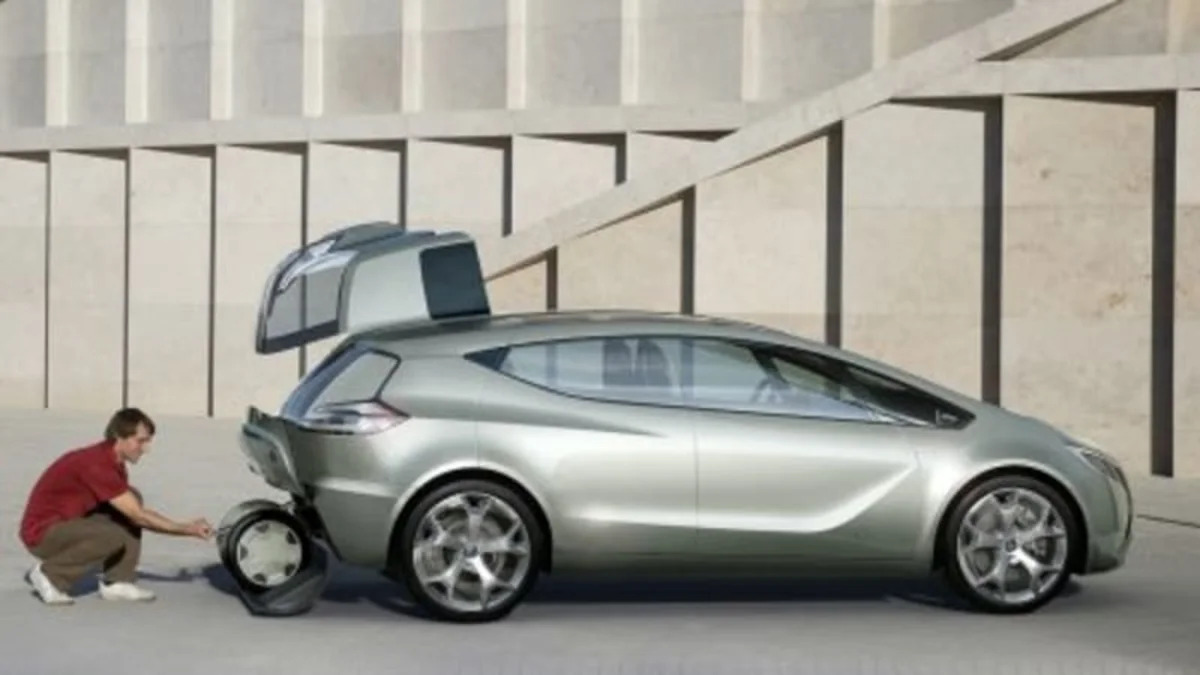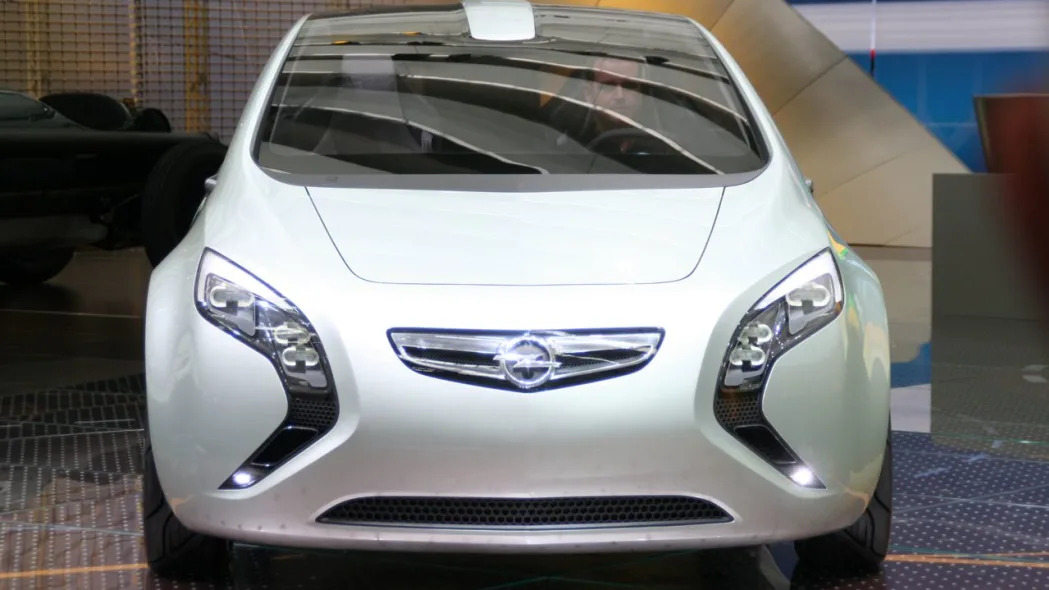Click to enlarge the Opel Flextreme E-Flex concept
We all got a premature look at the Opel's rendition of the GM's E-Flex platform over the weekend, but now we can reveal more details about the new Opel Flextreme concept. The third car uses a 1.3L common rail diesel engine as its range extender. Unlike the four door coupe/sedan styling of the Volt, this one has a mono-box layout with side-opening gullwing-style hatches over the rear cargo area.
The Flextreme has picked up styling cues from GTC concept coupe that debuted last March in Geneva, including the scalloped door panels and rear quarter shoulders. Aside from the styling, another unique feature of the Flextreme is the special cargo hold in the back that comes loaded with two Segway scooters. To ensure that the Segways are always ready to go, the compartment is equipped with charging points for the scooters.
General Motors has now done computer simulations of E-Flex running the European test cycle (ECE R101) that's used to determine fuel consumption and carbon dioxide emissions. The Flextreme scored a CO2 emissions rating of 40g/km which puts it at less than half of the best current production car the Smart ForTwo CDi which scores 88g/km. For more on the Flextreme differences from the Volt and the current state of development, check out AutoblogGreen.
[Sources: General Motors, AutoblogGreen]
We all got a premature look at the Opel's rendition of the GM's E-Flex platform over the weekend, but now we can reveal more details about the new Opel Flextreme concept. The third car uses a 1.3L common rail diesel engine as its range extender. Unlike the four door coupe/sedan styling of the Volt, this one has a mono-box layout with side-opening gullwing-style hatches over the rear cargo area.
The Flextreme has picked up styling cues from GTC concept coupe that debuted last March in Geneva, including the scalloped door panels and rear quarter shoulders. Aside from the styling, another unique feature of the Flextreme is the special cargo hold in the back that comes loaded with two Segway scooters. To ensure that the Segways are always ready to go, the compartment is equipped with charging points for the scooters.
General Motors has now done computer simulations of E-Flex running the European test cycle (ECE R101) that's used to determine fuel consumption and carbon dioxide emissions. The Flextreme scored a CO2 emissions rating of 40g/km which puts it at less than half of the best current production car the Smart ForTwo CDi which scores 88g/km. For more on the Flextreme differences from the Volt and the current state of development, check out AutoblogGreen.
[Sources: General Motors, AutoblogGreen]
GM Press Release:
Opel Flextreme Concept Expected to Achieve Less Than 40 gm/km CO2 Emissions
Plug-in Electric Vehicle Features 55 Km of Emissions-Free Range
FRANKFURT – General Motors Corp. today unveiled the Opel Flextreme concept electric vehicle, which based on the current European test cycle for plug-in vehicles is expected to emit only 40 g of C02 per kilometer (km), at the International Motor Show (IAA) in Frankfurt.
The Flextreme uses a diesel version of GM's E-Flex electric-drive system. In contrast to conventional vehicles and hybrids, E-Flex uses an electric motor, powered by a large lithium-ion battery, to propel the Flextreme for up to 55 km (34 miles) of electric-drive-only range. A 1.3 L turbo-biodiesel onboard engine creates additional electricity to replenish the battery and extend the vehicle's driving range to a total of 715 km (444 miles). Fully charged, the Flextreme's 55-km all-electric driving range is enough for most daily commuters in Europe to travel without using any diesel fuel or emitting any CO2.
"The Opel Flextreme diesel concept, the third variant of our E-Flex system, is a natural for the Opel/Vauxhall brand in Europe, where it has long been known for technological innovation and strong design," said Bob Lutz, GM Vice Chairman Global Product Development. "Commutes to major city-centers in Europe will do nothing but grow more challenging in the future, and we see E-Flex vehicles as an elegant solution for commuters."
With the E-Flex system, the generator, battery technology, plug and electric motor are the same in each variant – the source of additional electricity is what varies. The Opel Flextreme's 1.3 L common-rail diesel engine, which is not connected to the wheels, features a cylinder pressure-based closed loop process to control the combustion process and further reduce the vehicle's exhaust emissions.
The Flextreme's electric propulsion architecture also supports two Segway electric scooters with docking stations that are integrated into the vehicle's cargo area. The electric scooters are capable of up to 38 km (23 miles) of range, offering European customers greater access to places where cars are not allowed.
The E-Flex system was first shown in the Chevrolet Volt concept, which had its debut in January at the North American International Auto Show in Detroit. Volt is powered by a 16 kWh lithium-ion battery to power the vehicle for 64 km (40 miles) of all-electric range. A small biofuel engine with a generator is used to extend its range to more than 1000 km (640 miles).
A second E-Flex variant was shown in Shanghai with GM's new fifth-generation fuel cell propulsion technology and an 8 kwh lithium-ion battery to provide up to 483 km (300 miles) of petroleum- and emissions-free electric driving.
GM has initiated production engineering for the E-Flex System. Production timing is dependent on continued advances of key enabling technologies – specifically the development of lithium-ion batteries for hybrid and electric vehicle applications.
"We fully intend to bring this technology to market," said Frank Weber, Vehicle Line Executive and Vehicle Chief Engineer for the E-Flex system. "Although the battery required for the E-Flex system is still being developed, we're increasingly confident that our strategic battery partners – Compact Power, Inc.; and LG Chem, Continental Automotive Systems and A123Systems – will be able to deliver a production-ready battery in the near future."
The presentation of the E-Flex biodiesel variant is the latest step in GM's global efforts to diversify transportation away from petroleum and reduce CO2 emissions with a range of alternatives. These include:
- The 2008 launch of the Opel/Vauxhall Corsa 1.3 CDTI, the premiere model in the ecoFLEX range of vehicles, which emits just 119 g/km of CO2.
- Globally, GM is the leading producer of E85-capable biofuel vehicles, with more than 2 million on the road. This year, Saab will expand the availability of BioPower engines across its 9-3 and 9-5 portfolios, and E85 will be available on Cadillacs this autumn in Europe.
- The introduction of eco-Turbo engines that offer lower consumption and CO2 emissions, with no trade-off in acceleration or top speed compared to the large-displacement engines they replace.
- The introduction of the HydroGen 4 fuel cell vehicle and its inclusion in a global demonstration project to better understand the steps required to move hydrogen fuel cell vehicles toward commercialization.



Sign in to post
Please sign in to leave a comment.
Continue